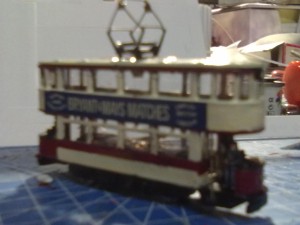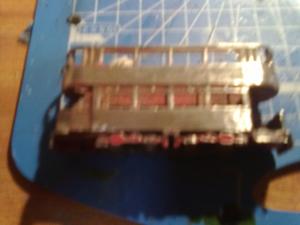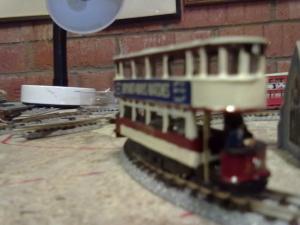Having built my trams they have to run on something, and if you are going to run trams then the carpet just will not do. I have to admit to having previously built a HO continental tram layout based on a layout which was at the 1994 Nuremberg toy fair, Hamannstadt. This layout had featured in the much missed Scale Model Trains magazine of May 1994 and I had extended and adapted the plan. Now I had less room and the old layout size of 2m x 1m in N gauge Trams would take forever to build.
I had a piece of the old tramway board which measured 1m x 50cm and this seemed to do the trick. I use chip board based on a 2″ x 1″ framework. I attached legs and I now had a board. The basic layout plan can be seen in fig 1
The next problem was to select track any railway track is never tight enough for a small tram layout and therefore all forms of railway track had to be avoided. Anyway trying to build my own tram track in N gauge seemed a step above and beyond the call of duty.
A visit to e bay revealed someone was selling Tomix track and the conversion set they sold to turn it into tram track a system it is a lot like the old Hartel system so seemed right for me and three bids later I had almost all the track I needed and enough of the conversion kits to make the system work. It was not cheap but it is good.
Tomix track however has certain problems, I have not yet found any tomix insulators and it is a pain to reduce in size. The first problem I over came by trial and error and eventually I found that Peco OO insulators and track joiners worked fine however you have to carefully remove the plastic underneath the track end. The latter problem remained and cutting track down to size was a problem which brute force and ignorance over came. The brute force being supplied by a minicraft saw and the ignorance by me.
I also found it helpful to wire the track before laying it. I must confess to having learnt my wiring skills from my grandfather who used to lecture for the old GPO and whilst it may be basic it does work. Therefore I had one common feed for the whole main oval and boke the other side of the rail into 20 different sections. This has the advantage of allowing multiple movement from one controller with out all this computer chip rubbish.
Tomix track is designed for a little purpose built track feed but I failed to track these down so I cut into the rail from below and soldered to the bottom of the track. It works well.
The over confusing thing about tomix track is the point motors but I will leave that for another date.
A final piece of advice is that the track needs good track pins and i always find that the nice pins of peco are fine for some jobs there is nothing like the track pins produced by Hornby for size and holding power they really are the six inch nails of the modelling world.
I’ll save the rest till next time which for all of you regular readers I promise will not be a long time off. Bye for now











